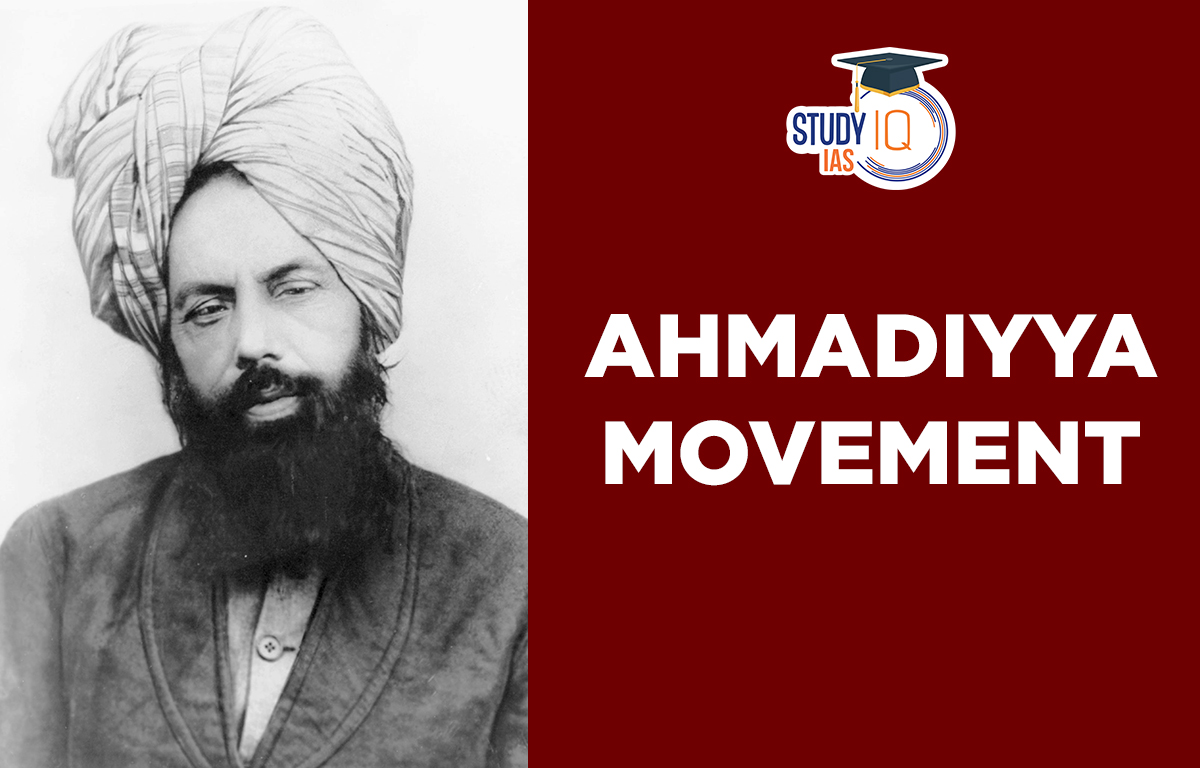Table of Contents
Ahmadiyya Movement
A contemporary Muslim messianic movement is the Ahmadiyya Movement. A Muslim sect with Indian roots is the Ahmadiyya. In the Indian province of Punjab in 1889, Mirza Ghulam Ahmad started the Ahmadiyya Movement. It was established on liberal principles. It referred to itself as the Mohammedan Renaissance’s standard-bearer and, like the Brahmo Samaj, was established on the notions of a single, universal religion for all people, rejecting jihad (sacred war against non-Muslims). In order to prepare for the UPSC Civil Service Exam, this article will provide you with information on the Ahmadiyya Movement.
In the General Studies Paper 1 of the UPSC-CSE, Modern History, the Ahmadiyya Movement is a significant subject. For candidates who will sit for the UPSC 2023 exam, this subject is crucial from the perspectives of the Preliminary and Main Exams.
Read More: Aligarh Movement
Ahmadiyya Movement History
This effort was started in 1889 by Mirza Gulam Ahmed to introduce western education to Indian Muslims. Similar to the Brahma Samaj, the organisation was founded on liberal ideals and those of a single, global religion for all people. It was established to defend Islam from the Arya Samaj and Christian missionaries’ rhetoric.
Gulam Ahmed claimed to be Jesus, the Hindu god Krishna, the prophet Masih, and the Mahdi when he made his earthly comeback in 1889. After the movement was accused of denying Muslim orthodoxy stating the finality of Muhammad’s prophethood, it faced ferocious resistance from the Sunni mainstream. The debate was just a philosophical dispute between private persons or nonprofit organizations during the time of British administration in India.
The issue became a crucial constitutional one after the bulk of Ahmadis migrated to Pakistan, a state that claims to be Islamic, in 1947. The majority of Sunni Muslims asked that Ahmadis be formally ejected from the Muslim community. This objective was accomplished in 1974 when the Pakistani parliament passed a constitutional amendment designating Ahmadis as non-Muslims in spite of their strenuous protest.
Read More: Faraizi Movement
Ahmadiyya Movement Founder
A contemporary Muslim messianic movement is the Ahmadiyya movement. Ghulam Ahmad founded it in the Indian province of Punjab in 1889. Mirz Ghulm Ahmad, an Indian religious figure and the father of the Ahmadiyya sect in Islam, lived from 13 February 1835 to 26 May 19008. He asserted that he had been chosen by God to be the predicted Messiah and Mahdi—the Muslim equivalent of Jesus’ second coming—as well as the Mujaddid (centennial reviver) of the 14th-century Islamic era.
Read More: Wahabi Movement
Ahmadiyya Movement Successors
When Hadhrat Mirza Ghulam Ahmad passed away in 1908, the movement was led by his elected successors, known as Khalifas al-Masih. The first successor was Hakim Noor-ud-din, who oversaw the movement from 1908 until his passing in 1914. Bashir ad-Din Hadhrat Mirza From 1914 to 1965, Mahmud Ahmad, the movement’s second Khalifa, served as its leader.
When Hadhrat Mirza Ghulam Ahmad passed away in 1908, the movement was led by his elected successors, known as Khalifas al-Masih. The first successor was Hakim Noor-ud-din, who oversaw the movement from 1908 until his passing in 1914. Bashir ad-Din Hadhrat Mirza From 1914 to 1965, Mahmud Ahmad, the movement’s second Khalifa, served as its leader.
Read More: Akali Movement
Ahmadiyya Movement Beliefs
The Ahmadiyya Movement prided itself on being the representative of the Mohammedan Renaissance and was established on liberal principles. Ghulam Ahmad was greatly influenced by Western liberalism, theosophy, and Hindu religious reform movements. The Ahmadiyyas stressed the value of human unity and condemned Jihad, or sacred war, against non-Muslims.
By building a network of institutions of higher education, the movement promoted Western liberal education among Indian Muslims. The only Islamic religion that holds that Mirza Ghulam Ahmad is the Messiah and that he came to put an end to religious strife and violence as well as to restore morality, peace, and justice is the Ahmadiyya community. They supported human rights and tolerance, as well as maintaining the mosque distinct from the government.
By building a network of institutions of higher education, the movement promoted Western liberal education among Indian Muslims. The only Islamic religion that holds that Mirza Ghulam Ahmad is the Messiah and that he came to put an end to religious strife and violence as well as to restore morality, peace, and justice is the Ahmadiyya community. They supported human rights and tolerance, as well as maintaining the mosque distinct from the government.
A “messianic sect of Islam” has been used to define the Ahmadiyya Muslim Movement. The following are the core tenets of the religion.
- According to Ahmadis, the Qadian branch of the Ahmadiyya Movement in Islam is the sole “embodiment of ‘True Islam,'”
- Ahmadis acknowledge that Muhammad was “the last and the sole law-bearer among the prophets,” but they also hold that “other minor prophets, such as [Hadhrat Mirza Ghulam Ahmad], who will refresh Muhammad’s teachings” may exist.
- Ahmadis think that Jesus won’t come back, but that someone in his “likeness” would arrive instead (ibid).
- Ahmadis think that although Jesus was killed on the cross, he did not actually perish.
Read More: Singh Sabha Movement
Ahmadiyya Movement Split
After the first Khalifa passed away in 1914, the Ahmadiyya Movement was divided into two separate branches: Ahmadis and the Lahore group in Islam. Muhammad Ali, also known as the Anjuman Isha’at-i-Islam (or the Ahmadiyya Movement), served as the first president, or as they say, “Amir,” of the Lahore organisation. He oversaw this movement until his passing in 1951.
Theological differences between the groupings contributed to this separation, as did disagreements over who should head movements after the death of a second successor. Since Hadhrat Mirza Ghulam Ahmed is seen by the Lahore Ahmadis as a mujahid (reformer) rather than a prophet, their movement is more inclined towards orthodox Islam.
Read More: Reform Movements by Parsi
Ahmadiyya Movement UPSC
Theological differences between the groupings contributed to this separation, as did disagreements over who should head movements after the death of a second successor. Since Hadhrat Mirza Ghulam Ahmed is seen by the Lahore Ahmadis as a mujahid (reformer) rather than a prophet, their movement is more inclined towards orthodox Islam.
Read More: Temple Entry Movement


 Birsa Munda Birth Anniversary 2025: Life...
Birsa Munda Birth Anniversary 2025: Life...
 Military Innovations of Afghans and Turk...
Military Innovations of Afghans and Turk...
 Self-Respect Movement, History, Objectiv...
Self-Respect Movement, History, Objectiv...

























